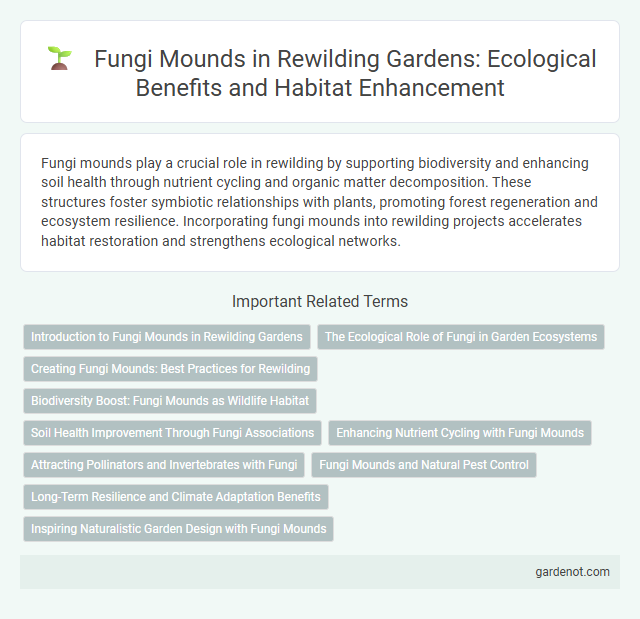Fungi mounds play a crucial role in rewilding by supporting biodiversity and enhancing soil health through nutrient cycling and organic matter decomposition. These structures foster symbiotic relationships with plants, promoting forest regeneration and ecosystem resilience. Incorporating fungi mounds into rewilding projects accelerates habitat restoration and strengthens ecological networks.
Introduction to Fungi Mounds in Rewilding Gardens
Fungi mounds in rewilding gardens serve as critical biodiversity hotspots, supporting nutrient cycling and soil health through the symbiotic relationships between fungi, plants, and microorganisms. These mounds create microhabitats that enhance moisture retention and provide shelter for various invertebrates, promoting ecosystem resilience. Incorporating fungi mounds accelerates natural decomposition, facilitating organic matter breakdown and enriching soil fertility in rewilded landscapes.
The Ecological Role of Fungi in Garden Ecosystems
Fungi mounds act as vital decomposers in garden ecosystems, breaking down organic matter into nutrients that enrich soil fertility and promote plant growth. Mycorrhizal fungi form symbiotic relationships with plant roots, enhancing water absorption and nutrient uptake, particularly phosphorus. These fungal networks also support biodiversity by creating habitats for microorganisms and contributing to soil structure and carbon cycling.
Creating Fungi Mounds: Best Practices for Rewilding
Creating fungi mounds involves selecting rich organic material such as wood chips, straw, and leaf litter to foster fungal growth and biodiversity. Position mounds in shaded, moist areas to mimic natural forest floor conditions, ensuring optimal colonization by mycelium and promoting nutrient cycling. Regular monitoring and minimal disturbance help sustain fungal networks essential for soil health and ecosystem restoration in rewilding projects.
Biodiversity Boost: Fungi Mounds as Wildlife Habitat
Fungi mounds create vital microhabitats that enhance biodiversity by providing shelter and food sources for numerous invertebrates, small mammals, and microorganisms. These structures promote symbiotic relationships, such as mycorrhizal networks, which improve soil health and plant growth. By encouraging diverse species interactions, fungi mounds play a crucial role in the ecological restoration and resilience of rewilding projects.
Soil Health Improvement Through Fungi Associations
Fungi mounds play a crucial role in rewilding by enhancing soil health through symbiotic associations with plant roots, known as mycorrhizal relationships. These fungi improve nutrient cycling, increase soil organic matter, and boost microbial diversity, leading to better soil structure and fertility. By promoting water retention and carbon sequestration, fungi mounds significantly contribute to ecosystem restoration and resilience.
Enhancing Nutrient Cycling with Fungi Mounds
Fungi mounds play a crucial role in enhancing nutrient cycling by breaking down organic matter and releasing essential nutrients back into the soil, which supports plant growth and ecosystem health. These structures increase microbial diversity and soil fertility, accelerating decomposition processes and promoting symbiotic relationships with plant roots. Incorporating fungi mounds in rewilding projects boosts soil regeneration, improves carbon sequestration, and fosters resilient habitats.
Attracting Pollinators and Invertebrates with Fungi
Fungi mounds create rich microhabitats that attract a diverse array of pollinators and invertebrates, enhancing biodiversity within rewilding projects. The decaying organic matter in fungi mounds provides essential nutrients and shelter for insects such as beetles, flies, and ants, which are critical for pollination and soil health. These habitats support complex ecological interactions that promote the regeneration of native plant species and ecosystem resilience.
Fungi Mounds and Natural Pest Control
Fungi mounds play a crucial role in natural pest control by fostering a diverse ecosystem of beneficial microorganisms that suppress harmful insect populations. These fungal networks enhance soil health, promoting the growth of plants with stronger natural defenses against pests. Integrating fungi mounds into rewilding projects boosts biodiversity and reduces the need for chemical pesticides, supporting sustainable landscape restoration.
Long-Term Resilience and Climate Adaptation Benefits
Fungi mounds play a crucial role in enhancing long-term ecosystem resilience by facilitating nutrient cycling and soil structure improvement, which boosts plant growth and biodiversity. Their mycelial networks aid in carbon sequestration, contributing significantly to climate adaptation strategies by stabilizing soil moisture and preventing erosion. Integrating fungi mounds into rewilding projects supports ecosystem stability and mitigates climate change impacts through improved habitat connectivity and resilience.
Inspiring Naturalistic Garden Design with Fungi Mounds
Fungi mounds provide a vital ecological function in rewilding by promoting nutrient cycling and soil health, inspiring naturalistic garden design that harmonizes with native ecosystems. Incorporating fungi mounds enhances biodiversity and creates microhabitats for beneficial organisms, supporting resilient and self-sustaining garden ecosystems. Gardeners adopting fungi mound techniques cultivate landscapes that mirror natural forest floors, fostering organic growth and ecological balance.
Fungi mound Infographic

 gardenot.com
gardenot.com